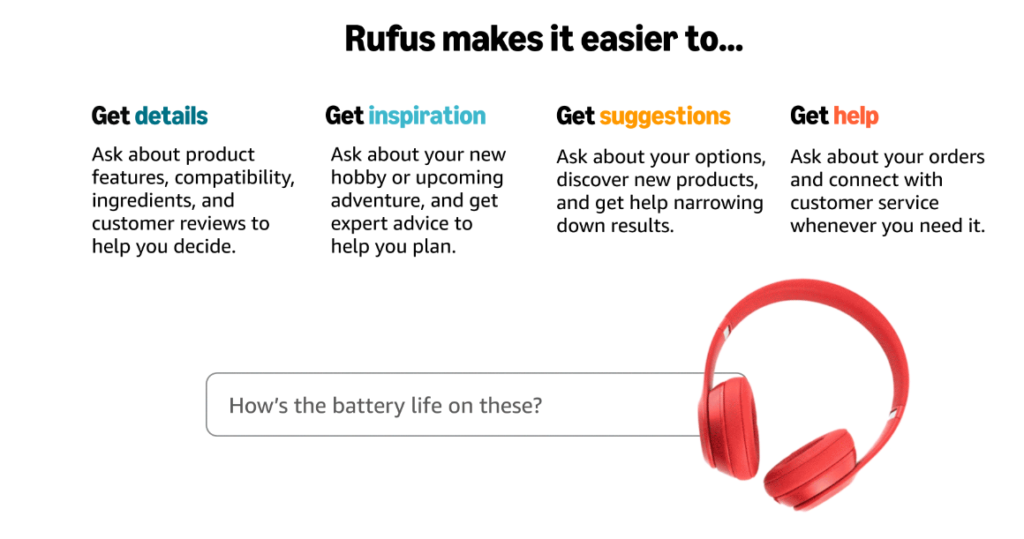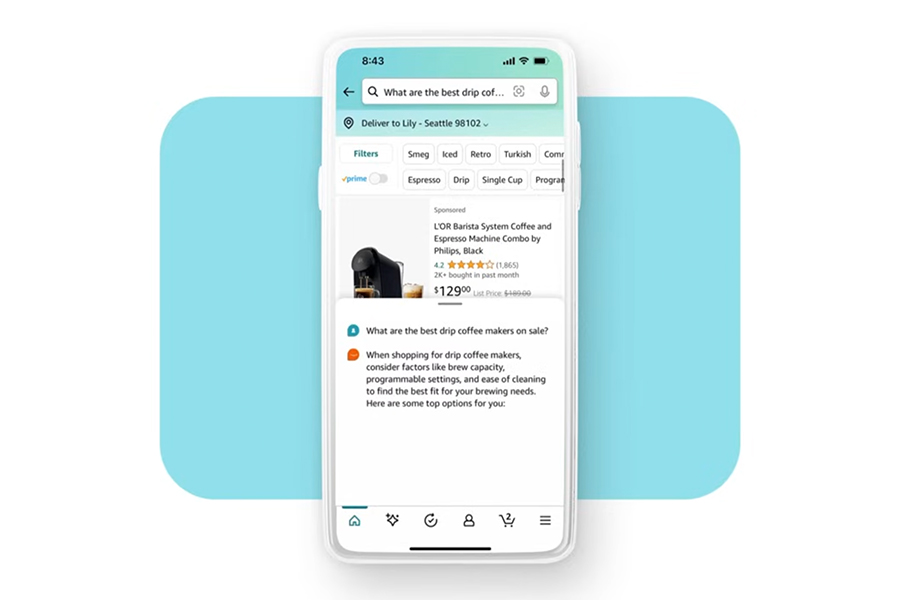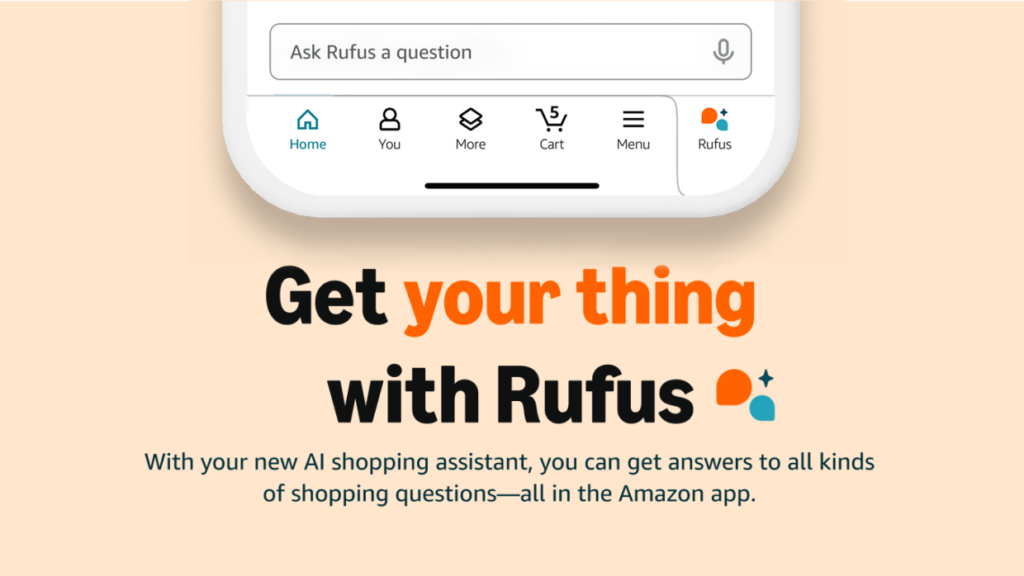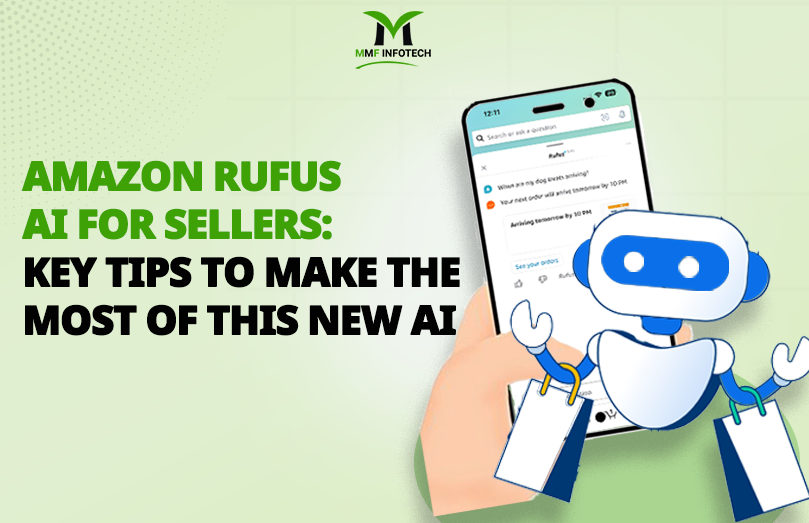- What Is Amazon Rufus AI?
- How to Start with Rufus AI?
- Customer Shopping Experience with Amazon Rufus AI
- Top Features of Amazon Rufus AI Every Seller Should Know
- Top 5 Tips to Use Amazon’s AI Chatbot Rufus for Listing Optimization
- Key Challenges and Solutions for Implementing Rufus AI
- Rufus AI for Amazon Sellers: The Future of E-Commerce
- Conclusion
Artificial intelligence is changing the definitions of human interaction, marketing methods, and style of living. It has also redefined the pattern of how buyers are attracted to products and purchase them. Therefore, the biggest online retailer in the world, Amazon, has also adopted AI techniques to enhance their customer’s shopping experience.
The newest generative AI tool, Amazon Rufus AI, has revolutionized the marketplace to provide creative solutions to both buyers and sellers. This tool was developed exclusively for Amazon customers.
So, if you are also a shopping enthusiast or a seller on Amazon, then let’s explore how Rufus AI can significantly help you!
What Is Amazon Rufus AI?
Rufus is a generative AI-powered shopping assistant that enhances Amazon customers’ experience by solving their questions about products on the Amazon shopping app. As an Amazon shopping assistant, this AI helps users explore products, provides suggestions according to their preferences, and responds to inquiries about particular products. This AI feature contains a chatbox where customers can easily type their queries and expect related answers.
For example, if you type “What are some deals for me?” or “When did I last order dog food?” in the chat box. Then, the AI will generate answers to your query and will also suggest some products based on your searches. However, sometimes results may not always be right according to your requirements. Rufus shows results virtually based on available product catalogs, customer reviews, community Q&As, and wider web information.

How to Start with Rufus AI?
Rufus’ AI feature is included in the Amazon app itself. Therefore, customers can now easily access Rufus AI once they update their Amazon shopping app.
To use Rufus AI, users need to start by simply clicking on the symbol located in the lower right corner of the Amazon mobile app. Once you click there, a dialogue window for Rufus chat will appear on their screen. Consumers can ask follow-up questions in the chat dialogue box, tap on suggested questions, and expand the chat discussion box to view answers to their inquiries.
At any point, users can swipe down to move the conversation dialogue box back to the bottom of their screen and dismiss Rufus to go back to their standard search results
Customer Shopping Experience with Amazon Rufus AI
While the sellers benefit from Amazon Rufus AI, customers also have numerous benefits from this new chatbot. AI is not just a business process improvement but also enhances product shopping in every step—from search to purchase. This high-end data-based AI tries to provide possible recommendations and real-time support through chatbots.
Amazon Rufus AI transforms the shopping experience by:
1. More Product Options
Usually, Amazon shows or recommends personalized products based on your searches. However, the Rufus AI takes it further. This generative AI analyses browsing history, previous purchases, and customer preferences to suggest the best products for you. From suggesting products that fit a particular need to suggesting an offer to a customer about some great deal that is about to expire, this AI ensures every customer interaction is more customized and valuable.
2. Accurate Search Results
Amazon Rufus enhances the search experience on the Amazon shopping app by using natural conversational language. For example, if you type “show me affordable running shoes,” then the Rufus AI will provide the best responses with images and filters like size, color, and price range to ensure more accurate searching. As the customer types, the AI predicts and auto-completes the search terms to improve the speed and relevance of a search.
3. Customer Assistance to Meet Your Needs
AI chatbots powered by Rufus are transforming customer service on Amazon. Customers can interact with AI-driven chatbots that provide instant answers to product inquiries, update orders, and connect with customer service, which improves over time by learning from past interactions. Customers are directed to help articles or video guides relevant to their issue, reducing dependency on human agents.
4. Shop by Occasion or Purpose
Customers can search for products or get recommendations on different events, purposes, occasions, and festivals. For example, if you type “gifting ideas for 5-year-old kid’s birthday” or “Christmas gift for office colleague”, then Rufus AI will suggest some products according to your needs.
5. Get Updates on the Latest Products
Customers can stay updated about the latest products and designs by taking assistance from Rufus. For example, you can take the help of Rufus by asking them questions like, “Suggest me some latest mobile phone”
Get Assistance While on the Product Detail Page
When on a particular product detail page, buyers can quickly examine an overview of customer reviews by tapping on “What do customers say?” Also, customers can use Rufus to quickly find answers to particular queries like “What is the warranty duration of this watch?” or “Is this cloth home washable?” To all these queries, Rufus will respond based on listing specifics, consumer feedback, and community Q&As.

Top Features of Amazon Rufus AI Every Seller Should Know
Rufus AI by Amazon certainly is a game-changer for any Amazon seller. Amazon Rufus AI is a new tool designed to smoothen selling on Amazon. This newly designed AI allows sellers to sell more efficiently and effectively on the Amazon marketplace.
Here are some features that turn Amazon Rufus AI into a valuable tool for Amazon sellers:
1. Product Recommendations
Rufus uses an AI algorithm to customize product recommendations according to each customer’s unique needs and tastes. With the help of this AI, customers are guided to products that closely match their unique needs and interests. Sellers get more recommendations based on good listings, reviews, and detailed information about the product.
2. Customer Interaction and Interpretation of Product Reviews
Rufus is being trained on product reviews on Amazon and the web. It responds to customer inquiries based on product reviews and customer feedback. Rufus will become more aware of recurring themes and sentiments in reviews as it discovers what motivates and discourages purchases. Therefore, sellers should focus more on encouraging positive feedback and solving negative reviews in time that have a chance of being featured by Rufus and improve by keywords like “top-rated products,” “verified customer satisfaction,” and “highly reviewed items.”
3. Listing Optimization
Rufus concentrates more on listings with quality images, readable product descriptions, and good integration of keywords and phrases. Therefore, with Rufus AI, sellers have to optimize their listing by creating a well-optimized product listing on Amazon, which requires deep knowledge of keywords, formatting, trends, and predictions for Amazon sellers.

Top 5 Tips to Use Amazon’s AI Chatbot Rufus for Listing Optimization
Optimizing listings with the help of Amazon’s AI chatbot Rufus is the key to better visibility and increased sales. Rufus helps make all the difference by providing data-driven results and suggestions.
Here are 5 tips to optimize your product listing with the help of Rufus AI.
1. Leverage Keyword Suggestions
Rufus can provide you with suggestions for targeted keywords based on the product category. Use Rufus to use high-ranking and relevant keywords for your listing. Use these keywords in your title, bullet points, and description to be more visible. Using Rufus, you can find backend search terms so you can become noticeable without leaving clutter on your listing.
2. Product Titles
A title for a product is important for its visibility in search and conversion rates. It should be readable and contain the relevant keywords. Use Rufus AI to get possible high-ranking keywords that are relevant to your product. Then, insert them organically into your title. For example, include key product features, such as material, size, or intended use, while keeping the title concise and readable.
3. Product Image
Write down easy-to-read important features and benefits of your product in the “About this item” section in bullet points with relevant SEO keywords under 200 characters. Include one bulletin about the brand. Do not include any shipping or promotional information. Use headers to summarize the description.
Product images attract customers, improve click-through rates, and affect decision-making. Rufus can provide insights on the type of images that perform best in your product category. Use its recommendations to ensure your main image is clear, high-resolution, and displays the product accurately. Avoid clutter and make sure the product is easily identifiable.
4. Product Descriptions
The product description allows you to showcase your product’s USP to the buyer. Take help from Rufus to get better product descriptions. Ask him to produce rich content for your products that will convey the worth of the product. Incorporate materials, user-generated content, and other unique differentiators in the product descriptions to help buyers arrive at the right purchasing decision.
5. Enhance Bullet Points
Write down easy-to-read important features and benefits of your product in the “About this item” section in bullet points with relevant SEO keywords under 200 characters. Rufus can suggest compelling bullet points that highlight the main benefits and features of your product.
Key Challenges and Solutions for Implementing Rufus AI
1. Scalability Issues
As the business scales, it becomes a concern not to let the scaling of Rufus AI compromise performance because AI models are known to require computational ability when training and in operation. If Rufus AI depends on cloud infrastructure, its scalability and speed will depend upon the limitations of cloud storage or processing resources.
2. Accuracy and Bias in Results
At times, the results from AI models are not quite accurate, for instance when they are built off less than diverse data. This may result in biased choices and suggestions that impact fairness and inclusion, Rufus. Establish continuous feedback loops to correct biased outputs and involve diverse teams in model development to lessen bias.

Rufus AI for Amazon Sellers: The Future of E-Commerce
Amazon is continuously adapting new AI features to enhance its customers and sellers experiences on the platform. Rufus AI is the latest feature changing the Amazon e-commerce business. Sellers are making full use of AI.
Rufus AI assists sellers in optimizing their listings to capture opportunities. Rufus AI for Amazon Sellers represents the future of e-commerce by transforming how sellers manage and optimize their listings. In a very competitive e-commerce landscape, AI is no longer a luxury; it’s a necessity to succeed on Amazon.
While Amazon continues to work on perfecting its AI technology, the future for sellers and customers in terms of intelligent and streamlined e-commerce is likely to shine.
Conclusion
Overall, Amazon Rufus AI is a profitable step in the right direction for sellers and customers. Amazon’s introduction of Rufus, the AI-powered shopping assistant marks a groundbreaking step in enhancing the virtual customer shopping journey. Amazon’s AI chatbot Rufus helps its sellers in product listing optimization, the status of orders, etc. For customers, Rufus AI enhances the shopping experience. It gives the best product recommendations with a personalized context and renders instant customer support through AI chatbots.
With Rufus’ generative AI power, online shopping becomes intuitive, faster, and more enjoyable, and therefore, sellers and customers sustain success within the ever-changing landscape of online retail.
Are you ready to take the jump on this revolutionary AI feature today?
Then, contact our experts to learn more about the best usage of Rufus AI.


